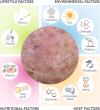Exposome and Skin. Part 2. The Influential Role of the Exposome, Beyond UVR, in Actinic Keratosis, Bowen's Disease and Squamous Cell Carcinoma: A Proposal
- PMID: 35112326
- PMCID: PMC8850498
- DOI: 10.1007/s13555-021-00644-3
Exposome and Skin. Part 2. The Influential Role of the Exposome, Beyond UVR, in Actinic Keratosis, Bowen's Disease and Squamous Cell Carcinoma: A Proposal
Abstract
Actinic keratosis (AK) is the main risk factor for the development of cutaneous invasive squamous cell carcinoma (SCC). It represents the first sign of severe chronic ultraviolet radiation exposure, which has a clear significant effect. Nevertheless, the skin is exposed to many other exposome factors which should be thoroughly considered. Our aim was to assess the impact of exposome factors other than ultraviolet radiation (UVR) on the etiopathology of AK and Bowen's disease (BD) and progression of AK to SCC and to design tailored prevention strategies. We performed an exhaustive literature search in September 2021 through PubMed on the impact of exposome factors other than UVR on AK, BD and SCC. We conducted several parallel searches combining terms of the following topics: AK, BD, SCC and microbiome, hormones, nutrition, alcohol, tobacco, viral infections, chemical contaminants and air pollution. Notably, skin microbiome studies have shown how Staphylococcus aureus infections are associated with AK and AK-to-SCC progression by the production of chronic inflammation. Nutritional studies have demonstrated how a caloric restriction in fat intake, oral nicotinamide and moderate consumption of wine significantly reduce the number of premalignant keratoses and SCC. Regarding lifestyle factors, both alcohol and smoking are associated with the development of SCC in a dose-dependent manner. Relevant environmental factors are viral infections and chemical contaminants. Human papillomavirus infections induce deregulation of cellular proliferation and are associated with AK, BD and SCC. In addition to outdoor jobs, occupations such as industrial processing and farming also increase the risk of developing keratoses and SCC. The exposome of AK will undoubtedly help the understanding of its etiopathology and possible progression to SCC and will serve as a basis to design tailored prevention strategies.
Keywords: Actinic keratosis; Dermatology; Environmental factors; Exposome; Hormones; Microbiome; Nutrition; Pollution; Prevention strategies; Squamous cell carcinoma.
© 2022. The Author(s).
Figures
Similar articles
-
Cyclin A and beta-catenin expression in actinic keratosis, Bowen's disease and invasive squamous cell carcinoma of the skin.Br J Dermatol. 2005 Dec;153(6):1166-75. doi: 10.1111/j.1365-2133.2005.06898.x. Br J Dermatol. 2005. PMID: 16307653
-
Comparison of oxidative stress on DNA, protein and lipids in patients with actinic keratosis, Bowen's disease and squamous cell carcinoma.J Dermatol. 2018 Nov;45(11):1319-1323. doi: 10.1111/1346-8138.14631. Epub 2018 Sep 17. J Dermatol. 2018. PMID: 30222205
-
In vivo microvascular imaging of cutaneous actinic keratosis, Bowen's disease and squamous cell carcinoma using dynamic optical coherence tomography.J Eur Acad Dermatol Venereol. 2017 Oct;31(10):1655-1662. doi: 10.1111/jdv.14335. Epub 2017 Jun 20. J Eur Acad Dermatol Venereol. 2017. PMID: 28502083 Clinical Trial.
-
Progression of actinic keratosis to squamous cell carcinoma revisited: clinical and treatment implications.Cutis. 2011 Apr;87(4):201-7. Cutis. 2011. PMID: 21644496 Review.
-
Premalignant and early squamous cell carcinoma.Clin Plast Surg. 2005 Apr;32(2):223-35. doi: 10.1016/j.cps.2004.11.001. Clin Plast Surg. 2005. PMID: 15814119 Review.
Cited by
-
Exploring the impact of solar radiation on skin microbiome to develop improved photoprotection strategies.Photochem Photobiol. 2025 Jan-Feb;101(1):38-52. doi: 10.1111/php.13962. Epub 2024 May 20. Photochem Photobiol. 2025. PMID: 38767119 Free PMC article. Review.
-
Clinical and histopathological characteristics, diagnosis and treatment, and comorbidities of Bowen's disease: a retrospective study.Front Med (Lausanne). 2023 Nov 15;10:1281540. doi: 10.3389/fmed.2023.1281540. eCollection 2023. Front Med (Lausanne). 2023. PMID: 38034527 Free PMC article.
-
Effects of Air Pollution on Cellular Senescence and Skin Aging.Cells. 2022 Jul 17;11(14):2220. doi: 10.3390/cells11142220. Cells. 2022. PMID: 35883663 Free PMC article. Review.
-
From actinic keratosis to cutaneous squamous cell carcinoma: the key pathogenesis and treatments.Front Immunol. 2025 Jan 24;16:1518633. doi: 10.3389/fimmu.2025.1518633. eCollection 2025. Front Immunol. 2025. PMID: 39925808 Free PMC article. Review.
-
Air Pollution and Skin Diseases.Ann Dermatol. 2025 Apr;37(2):53-67. doi: 10.5021/ad.24.159. Ann Dermatol. 2025. PMID: 40165563 Free PMC article. Review.
References
-
- Marks R, Rennie G, Selwood TS. Malignant transformation of solar keratoses to squamous cell carcinoma. Lancet. 1988;1(8589):795–797. - PubMed
-
- Berker D, McGregor JM, Hughes BR, British Association of Dermatologists Therapy Guidelines and Audit Subcommittee Guidelines for the management of actinic keratoses. Br J Dermatol. 2007;156:222–230. - PubMed
-
- Stockfleth E, Kerl H, Guideline Subcommittee of the European Dermatology Forum Guidelines for the management of actinic keratoses. Eur J Dermatol. 2006;16:599–606. - PubMed
-
- Heaphy MR, Jr, Ackerman AB. The nature of solar keratosis: a critical review in historical perspective. J Am Acad Dermatol. 2000;43(1 Pt 1):138–150. - PubMed
-
- De Oliveira ECV, da Motta VRV, Pantoja PC, et al. Actinic keratosis—review for clinical practice. Int J Dermatol. 2019;58(4):400–407. - PubMed
Publication types
LinkOut - more resources
Full Text Sources
Research Materials


